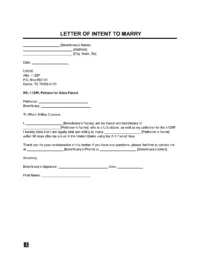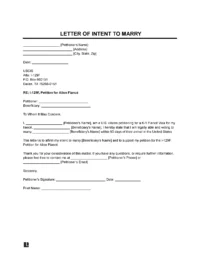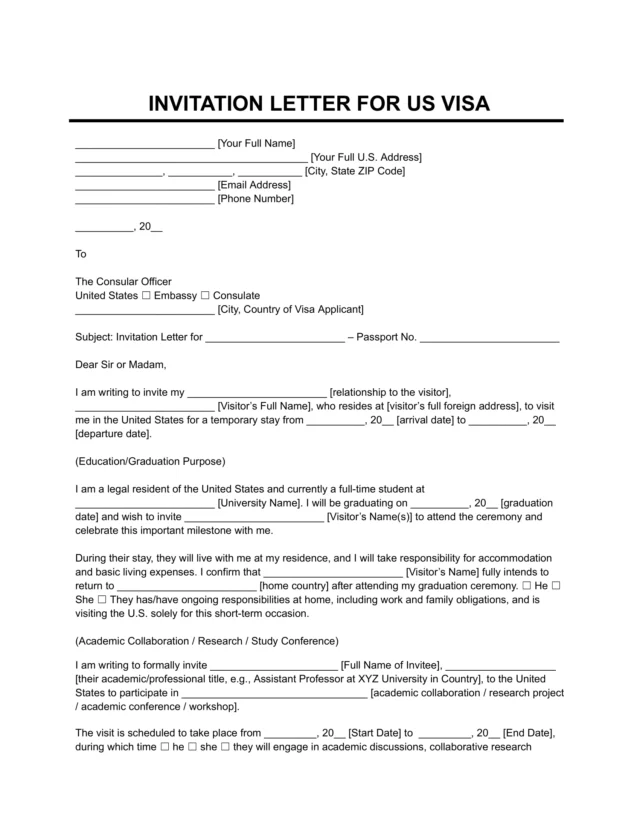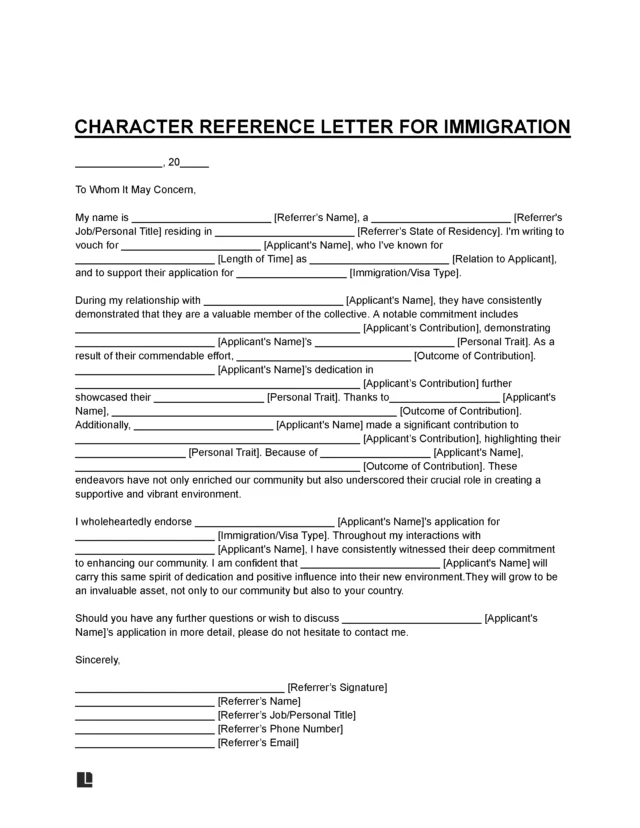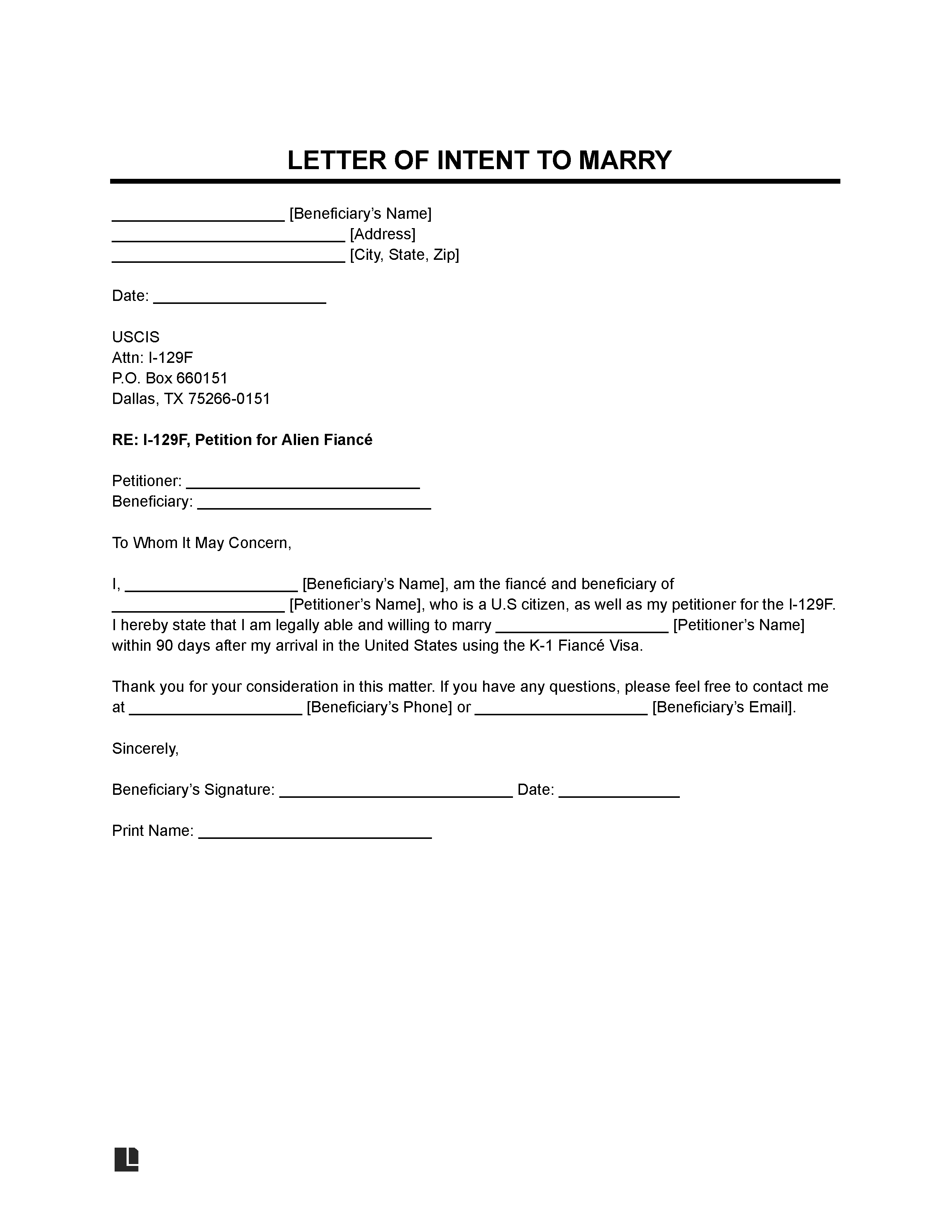A letter of intent to marry (within 90 days) shows that an alien fiancé and a US citizen petitioner intend to marry each other within 90 days of the alien fiancé arriving in the US. It’s a required document that allows the petitioner to complete Form I-129F and the foreign fiancé to apply for a K-1 visa.
Both the petitioner and the beneficiary must write a letter of intent to marry. Two letters (one from each party) show that the couple’s relationship exists in good faith and they have a genuine connection.
Process of Marrying a Foreign Fiancé
Here’s an overview of the process of marrying a foreign fiancé, including how an intent to marry letter fits into the process:
Step 1 – Ensure You Fulfill Basic Eligibility Requirements
Before proceeding with the subsequent steps, ensure you meet the basic eligibility requirements:
- You (as the petitioner) are a US citizen.
- You and your fiancé are free and have the legal ability to marry (neither of you are already married).
- You and your fiancé have met at least once in person within two years before filing the petition.
What If You and Your Fiancé Haven't Had an In-Person Meeting?
In some cases, you and your fiancé won’t be able to meet in person. You’ll be eligible for a waiver from this requirement if one of the two following circumstances apply:
- An in-person meeting would result in extreme hardship for you; or
- An in-person meeting would breach deeply ingrained customs or established social practices in your or your fiancé’s culture.
Step 2 – Complete a Letter of Intent to Marry
Another basic eligibility requirement is that you and your soon-to-be spouse must show that you intend to marry each other within 90 days of them entering the US. The United States Citizenship and Immigration Services (USCIS) requires an intent to marry letter from both parties, as it shows proof of a bona fide relationship.
While you can provide additional supporting evidence of an impending marriage, such as past correspondence, venue reservations, and wedding plans, letters of intent are required to marry a foreign fiancé.
Step 3 – Fill Out Form I-129F
With steps one and two complete, you can proceed to fill out Form I-129F (Petition for Alien Fiancé) in its entirety. As the US citizen petitioner, you should be the party filling it out.
Provide comprehensive information on you and your fiancé. Attach the letters of intent and other documentation the form requires, including evidence of US citizenship and termination of previous marriages (if applicable).
Signature Requirements: The US citizen petitioner must sign the form. The USCIS will deem any typewritten or stamped name in place of a signature invalid. The USCIS will accept a scanned, faxed, or photocopied copy of an original handwritten signature for filing purposes. The scan, fax, or photocopy should be of the original document and contain the handwritten ink.
Where to Send
Once the petitioner completely fills out Form I-129F, they must send it to the USCIS Dallas lockbox:
The USCIS address for US Postal Service (USPS) is as follows:
USCIS
Attn: I-129F
PO Box 660151
Dallas, TX 75266-0151
The USCIS address for FedEx, UPS, and DHL deliveries is as follows:
USCIS
Attn: I-129F (Box 660151)
2501 South State Highway 121 Business
Suite 400
Lewisville, TX 75067-8003
Step 4 – Wait for Approval from the USCIS
Wait for the USCIS to approve your petition. Upon approval, they will send the form to the National Visa Center. From there, the center will process and forward your petition to the US Embassy or consulate closest to your foreign fiancé’s residence.
Step 5 – Have Your Fiancé Apply for Their K-1 Visa
Your foreign fiancé will receive an invitation from the relevant US Embassy or consulate to apply for a K-1 visa.
Have them complete Form DS-160 (the Online Nonimmigrant Visa Application) and pay the associated fee. They should also schedule a medical examination with an approved healthcare provider and an interview at the US Embassy or Consulate.
They should prepare for questions pertaining to the relationship so that they can verify its nature and legitimacy. The consular employee will issue a K-1 visa stamp in the fiancé’s passport upon approval of the visa.
Step 6 – Marry Upon Your Fiancé’s Arrival in the US
With the K-1 visa stamp in their passport, the fiancé can travel to the US. When they arrive, they should legally marry their US citizen petitioner within 90 days.
Step 7 – Have Your Foreign Spouse Apply for an Adjustment of Status
The K-1 visa isn’t meant to be a long-term solution; it will only allow you and your foreign fiancé to marry. After you get married, your foreign spouse should file Form I-485 (Application to Register Permanent Residence or Adjust Status). This form lets them apply for an adjustment of status, meaning they can become a lawful permanent resident as a green card holder.
What to Include in a Letter of Intent to Marry (Within 90 Days)
Here are some of the key elements to include in a letter of intent to marry (within 90 days):
- Petitioner name, address, and contact information
- Beneficiary name, address, and contact information
- Statement of intent to marry within 90 days
- Description of the nature of the relationship and the reasons for marrying each other
- USCIS’s address
- Signature from the authorizing party (both parties should write and sign their own letter)
Letter of Intent to Marry (Within 90 Days) Samples
You’ll use a different version of a letter of intent to marry (within 90 days) depending on whether you’re the beneficiary or petitioner:
Frequently Asked Questions
What is the filing fee for Form I-129F?
Currently, the paper filing fee for Form I-129F is $675. However, you can refer to the G-1055 Fee Schedule for the most up-to-date information.
What happens if the couple doesn’t get married within 90 days of the alien fiancé arriving in the US?
Here are some potential consequences if a couple doesn’t marry within 90 days of the fiancé’s arrival:
- Status violation: Failure to marry will result in a violation of the foreign fiancé’s nonimmigrant status.
- Deportation: The USCIS may arrange for the fiancé’s deportation from the US.
- Difficulty with Immigration in the Future: A foreign fiancé may have difficulty with getting visa requests or immigration applications approved in the future.
If the couple still plans to get married, the foreign fiancé may be able to reapply for a new K-1 visa. The US citizen petitioner will have to fill out a new Form I-129F.
What evidence should I submit with Form I-129F?
The evidence you should submit with Form I-129F includes the following:
- Proof of Eligibility: Submit your and your fiancé’s biographic information and proof of your US citizenship.
- Proof of Intent to Marry: Both parties should submit a letter stating their intent to marry the other party.
- Proof of Relationship: You may submit evidence of your and your fiancé’s relationship, including pictures, travel records, and communication records.
- Death Certificates or Divorce Decrees: If you and your fiancé were previously married, include death certificates or divorce decrees to show that those previous marriages are over.
Please review the USCIS’s instructions for the most updated evidence requirements.


